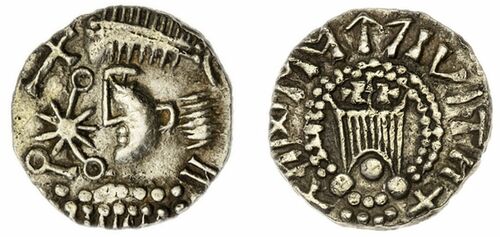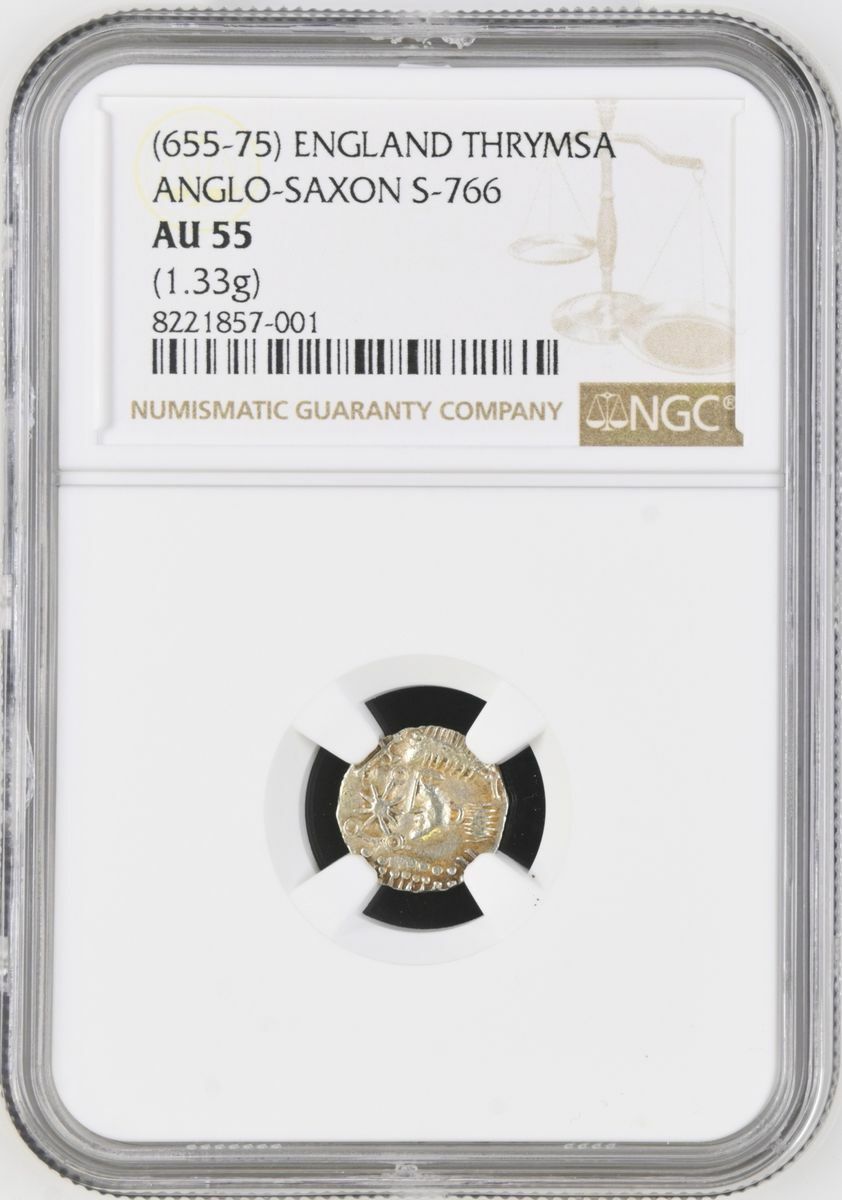Auction: 24005 - The Official Coinex Auction of Ancient, British and World Coins
Lot: 257
NGC AU55 | *Top Pop* | Early Anglo-Saxon England, 'Post-Crondall' Period, East Anglian Issues, "Trophy" Series, Gold Shilling or Thrymsa, c. 650-670, 'Runic Ring-Bearer' type, double-diademed and radiate bust left, wearing pelleted cuirass, crucific before face, star in annulate trilobe below, rev. Runic legend around double pelleted circle containing Roman trophy with two crosses below, 1.33g, 9h (EMC 1998.0081 [Billockby] = Spink 126, 14 July 1998, lot 586 = Marsden 20 = MEC 8, 14 = GCASE 780 same dies; EMC 2023.0098 [East Bergholt], same dies; SCBI Abramson –; SCBI BM –; Sutherland –; Metcalf –; N –; S.766), of pale gold fabric, on a rather full flan, a most pleasingly good very fine, excessively rare, the third recorded specimen, in NGC holder, graded AU55 (Cert. #8221857-001) [*Single Finest Certified*]
Provenance
Found near Eye (Suffolk), 28 May 2024
~ Recorded with the Fitzwilliam Museum, ref. EMC Pending ~
~ Authenticated by the Numismatic Guaranty Corporation, graded NGC AU55 ~
https://www.ngccoin.com/certlookup/8221857-001/55/
Evidence for the native-production of gold coins in seventh century England remains frustratingly rare, even with the advent of widespread metal detecting across the British isles swelling this and many other syllogae. To date, just over 20 specimens have been officially documented (up from just seven at the time of the July 1998 sale), and intriguingly struck from just five obverse dies. Were proof required, this would point definitively towards an extremely restricted production cycle, and a probable lack of initiative towards the currency operating effectively as practical specie.
Clues as to its purpose are afforded by its rather incongruous iconography. Unusually for the epoch, the obverse loans not from Roman prototypes, but entirely original composition. Typically the portrait faces right, with the emblems of Christianity before the face in the right field. The design carried here represents an intriguing reversal.
As re-iterated by the late Dr Metcalf in the footnote to our 1998 sale listing, the production of such coins ought to be associated with the site of Medeshamsted Abbey (Peterborough), which had been founded (Anglo-Saxon Chronicle, AD 656, attests), in the witness of King Wulfhere of Mercia, King Oswy of Northumbria and Kings Sigehere and Sebbi of Essex, 'with their finger on Christ's cross'. However, the documented find-spots for the issue, as cemented by the present find, indicate a pattern of circulation with a particular cluster in Suffolk.
As Adrian Marsden noted: 'The annulets could well represent rings. The bestowing of rings by lords to their sworn followers was a feature of Anglo-Saxon society and is reflected in the heroic poetry of the age'...'If - as seems likely - the portraits represent the king of East Anglia, then they mark him out as both a Christian lord and perhaps also a ring-giver in the tradition of his ancestors'.
Subject to 20% VAT on Buyer’s Premium. For more information please view Terms and Conditions for Buyers.
Sold for
£12,000
Starting price
£12000









